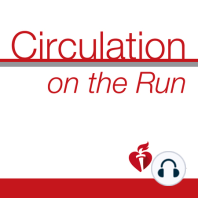23 min listen
Circulation March 21, 2017 Issue
ratings:
Length:
18 minutes
Released:
Mar 20, 2017
Format:
Podcast episode
Description
Dr. Lam: Welcome to Circulation on the Run, your weekly podcast summary and backstage pass to The Journal and its editors. I'm Dr. Carolyn Lam, associate editor from the National Heart Center and Duke National University of Singapore. In this week's issue, we are discussing if public placement of defibrillators in the community can be improved. First, here's your summary of this week's Journal. Stroke incidents, prevalence, and risk factors have been changing over the past 50 years so do we need a more contemporaneous revised Framingham Stroke Risk profile to reflect these trends? Well the first paper in our issue looks at this and this is from first author Dr. Dufouil, corresponding author Dr. Seshadri and colleagues from the Boston University School of Medicine. Let's first recall that the Framingham Stroke Risk profile was originally described in 1991 and integrates the effect of age, sex, and baseline measurements of various vascular risk factors such as systolic blood pressure, use of anti-hypertensive medications, left ventricular hypertrophy on ECG, prevalent cardiovascular disease, current smoking status, atrial fibrillation and diabetes all to describe the 10-year probability of incident stroke. In the current paper, the authors updated the Framingham Stroke Risk profile using the means of risk factors that reflect current prevalence, the estimate of incident stroke to reflect current rates, and the hazards ratio that reflect current associations. They used the same risk factors identified in the original stroke risk profile with the exception of left ventricular hypertrophy. The authors compared the accuracy of the standard old risk profile with the revised new risk profile in predicting the risk of [alt 00:01:58] and ischemic stroke and validated the new risk profile in two external cohorts, the three cities and regards or reasons for geographic and ethnic differences in stroke studies. They found that the new stroke risk profile was a better predictor of current stroke risks in all three samples than the original old Framingham Stroke Risk profile. The new stroke risk profile was also a better predictor among whites compared to blacks in the regard study. The authors therefore concluded that a more contemporaneous revised Framingham Stroke Risk profile could serve as the basis for examining geographic and racial differences in stroke risk and the incremental diagnostic utility of novel stroke risk factors. The next study provides preclinical proof of principle that an apelin receptor agonist may be of therapeutic use in pulmonary arterial hypertension. And the agonist in this case is Elabela/Toddler or ELA, first identified as an essential peptide in the development of the heart in Zebrafish, and subsequently proposed as a second endogenous ligand at the G-protien coupled apelin receptor, which works at this receptor despite a lack of sequence similarity to the established ligand, apelin. In this study from first author Dr. Yang, corresponding author Dr. Davenport and colleagues from University of Cambridge in the United Kingdom, ELA competed for binding of apelin in human hearts with overlap of the two peptides indicated by encyclical modeling. ELA activated G-protein and β-arrestin dependent pathways and as expression was detectable in human vascular endothelium and plasma. Comparable to apelin, ELA increased cardiac contractility, ejection fraction, cardiac output, and elicited vasodilatation in rats in vivo. ELA expression was reduced in cardiopulmonary tissues from patients with pulmonary arterial hypertension and in rat models. Finally, ELA
Released:
Mar 20, 2017
Format:
Podcast episode
Titles in the series (100)
Circulation September 19, 2017 Issue: Circulation Weekly: Your Weekly Summary & Backstage Pass To The Journal by Circulation on the Run
